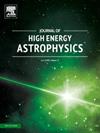Radiative back-reaction on charged particle motion in the dipole magnetosphere of neutron stars
IF 10.2
4区 物理与天体物理
Q1 ASTRONOMY & ASTROPHYSICS
引用次数: 0
Abstract
The motion of charged particles under the Lorentz force in the magnetosphere of neutron stars, represented by a dipole field in the Schwarzschild spacetime, can be determined by an effective potential, whose local extrema govern circular orbits both in and off the equatorial plane, which coincides with the symmetry plane of the dipole field. In this work, we provide a detailed description of the properties of these “conservative” circular orbits and, using the approximation represented by the Landau-Lifshitz equation, examine the role of the radiative back-reaction force that influences the motion of charged particles following both the in and off equatorial circular orbits, as well as the chaotic orbits confined to belts centered around the circular orbits. To provide clear insight into these dynamics, we compare particle motion with and without the back-reaction force. We demonstrate that, in the case of an attractive Lorentz force, the back-reaction leads to the charged particles falling onto the neutron star's surface in all scenarios considered. For the repulsive Lorentz force, in combination with the back-reaction force, we observe a widening of stable equatorial circular orbits; the off-equatorial orbits shift toward the equatorial plane and subsequently widen if they are sufficiently close to the plane. Otherwise, the off-equatorial orbits evolve toward the neutron star surface. The critical latitude, which separates orbital widening from falling onto the surface, is determined numerically as a function of the electromagnetic interaction's intensity.
中子星偶极磁层中带电粒子运动的辐射反作用
中子星磁层中的带电粒子在洛伦兹力作用下的运动可以由一个有效势能来确定,该势能的局部极值支配着赤道面内外的圆形轨道,而赤道面与偶极子场的对称面重合。在这项研究中,我们详细描述了这些 "保守 "圆轨道的特性,并利用兰道-利夫希茨方程所代表的近似方法,研究了辐射反作用力的作用,这种反作用力影响着赤道内和赤道外圆轨道上带电粒子的运动,以及局限于以圆轨道为中心的带状区域内的混沌轨道。为了清楚地了解这些动力学,我们比较了有反作用力和没有反作用力的粒子运动。我们证明,在有吸引力洛伦兹力的情况下,反作用力会导致带电粒子在所考虑的所有情况下都落到中子星表面。对于洛伦兹斥力,结合反作用力,我们观察到稳定的赤道圆形轨道变宽;如果离赤道平面足够近,偏离赤道的轨道会向赤道平面移动,随后变宽。否则,偏离赤道的轨道会向中子星表面演化。临界纬度是轨道变宽与坠落到表面之间的分界线,它是通过数值确定的,是电磁相互作用强度的函数。
本文章由计算机程序翻译,如有差异,请以英文原文为准。
求助全文
约1分钟内获得全文
求助全文
来源期刊

Journal of High Energy Astrophysics
Earth and Planetary Sciences-Space and Planetary Science
CiteScore
9.70
自引率
5.30%
发文量
38
审稿时长
65 days
期刊介绍:
The journal welcomes manuscripts on theoretical models, simulations, and observations of highly energetic astrophysical objects both in our Galaxy and beyond. Among those, black holes at all scales, neutron stars, pulsars and their nebula, binaries, novae and supernovae, their remnants, active galaxies, and clusters are just a few examples. The journal will consider research across the whole electromagnetic spectrum, as well as research using various messengers, such as gravitational waves or neutrinos. Effects of high-energy phenomena on cosmology and star-formation, results from dedicated surveys expanding the knowledge of extreme environments, and astrophysical implications of dark matter are also welcomed topics.
 求助内容:
求助内容: 应助结果提醒方式:
应助结果提醒方式:


